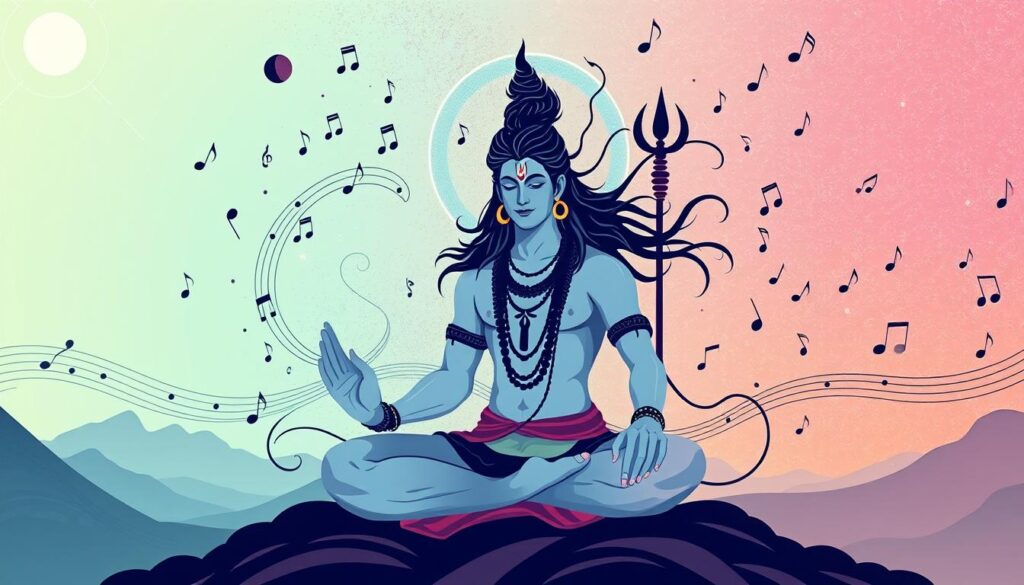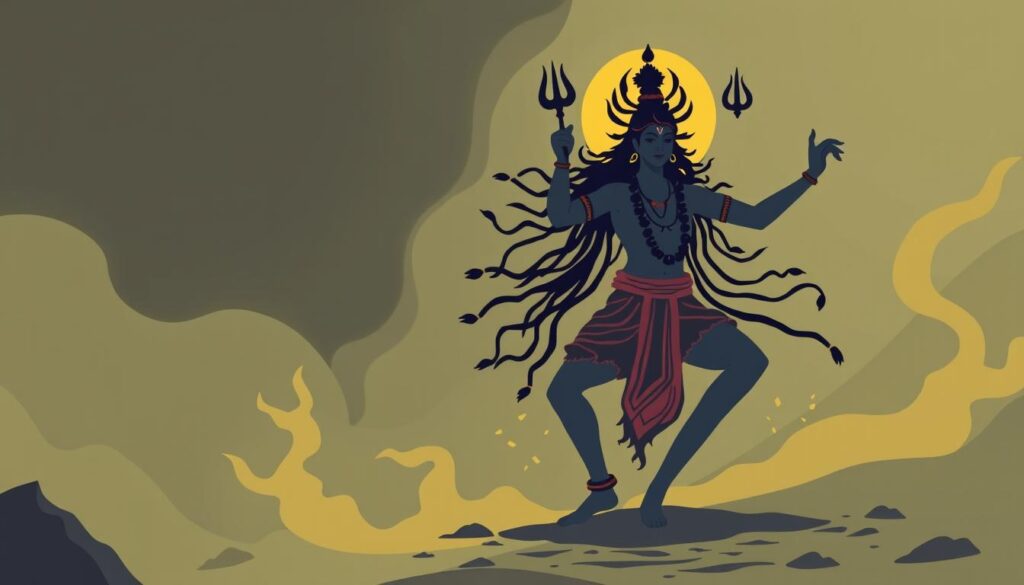
In the heart of the mystical Hindu universe, a captivating dance unfolds. It shows the essence of creation and destruction. This is the Shiv Tandav, the cosmic dance of Lord Shiva.
Imagine a majestic figure with serpents and a crescent moon. His third eye blazes with divine power. This is Shiva, the Destroyer, the Transformer, and the Regenerator.
The Shiv Tandav shows the endless dance of creation, preservation, and dissolution. It proves that all things are impermanent. Through this dance, Shiva teaches us about the fleeting nature of existence.
Key Takeaways
- Shiv Tandav is the cosmic dance of Lord Shiva, embodying the eternal cycle of creation, preservation, and destruction.
- Shiva’s dance mirrors the dynamic forces that govern the universe, symbolizing the ebb and flow of existence.
- The Tandav is depicted in various forms, each representing a different aspect of Shiva’s divine nature, such as Rudra Tandava (destruction), Ananda Tandava (joyful creation), and Gyan Tandava (enlightenment).
- Shiv Tandav is deeply rooted in Hindu mythology and scriptures, with references found in texts like the Rigveda, Yajurveda, and Natya Shastra.
- The sculpture of Shiva as Nataraja, the Cosmic Dancer, is a prominent representation of the Tandav in Indian art and architecture.
Understanding the Divine Dance of Creation
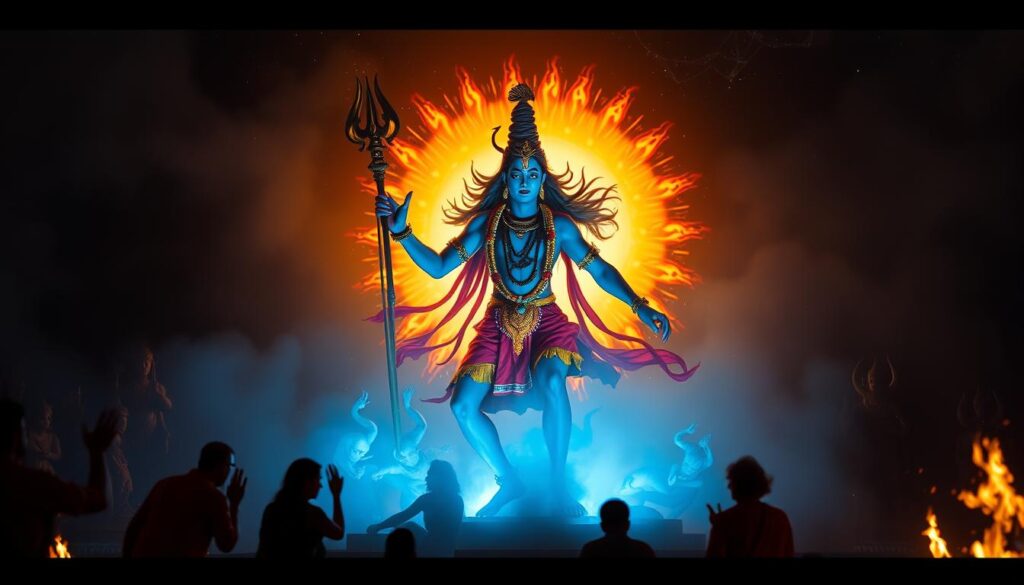
The cosmic dance of Lord Shiva is called the Shiv Tandav. It’s like a deep system in creation. In Hindu stories, Shiva’s dance shows the cycle of life, death, and rebirth.
The Cosmic Symphony of Movement
Shiva’s dance makes vibrations that match the universe’s heartbeat. It shows how cosmic forces guide life’s cycles. This divine dance tells us about personal growth and facing challenges.
Sacred Symbolism in Motion
Shiva’s dance shows creation. His cosmic symphony brings new worlds into being. It’s a never-ending cycle of making new things.
Preservation is also part of the dance. It keeps the universe balanced and peaceful. This balance is key for the universe to flourish.
The Universal Rhythm
Destruction is a part of Shiva’s dance too. It’s not bad; it’s a change that leads to new beginnings. The Tandava reminds us of the universal rhythm that rules everything.
“The Tandava serves as an allegory for personal journeys, emphasizing individual growth, challenges, and evolution of consciousness, aligning individuals with the dynamic forces governing the universe.”
The Origins and Mythology of Shiv Tandav
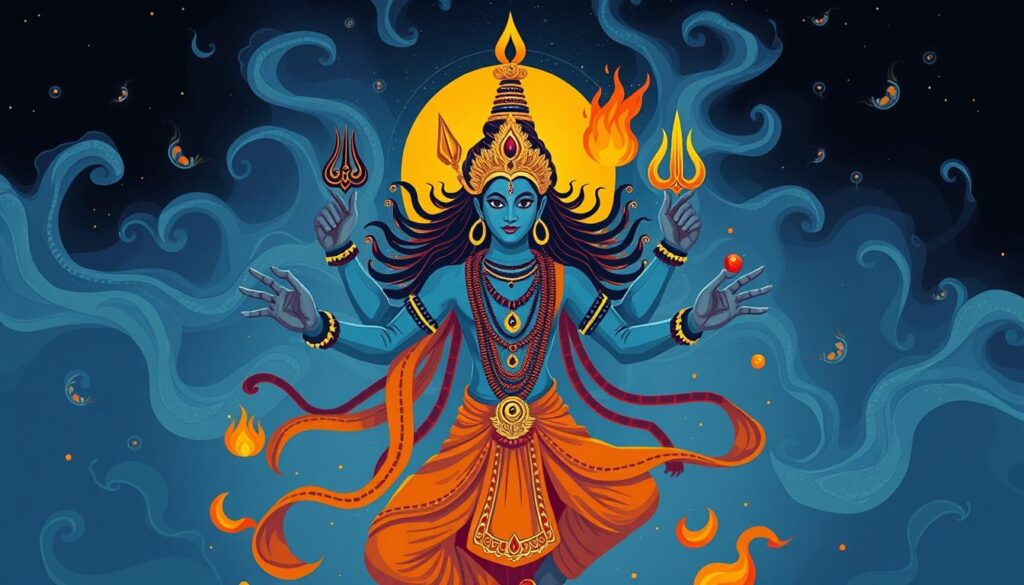
The dance of Lord Shiva, called Shiv Tandav, comes from Southern India’s puranic lore. It’s especially famous in Tamil Nadu. This dance shows the joy of creation, coming from stillness.
The Nataraja form in Chidambaram temple shows this stillness. It shows the dance’s mix of being involved and detached in spiritual search.
The Shiva Tandava Stotra is a sacred hymn in Indian mythology. It’s said to have been written by Hindu god Shiva himself. The story says Ravana, a demon-king, wrote it as a tribute to Shiva. He got the sword Chandrahasa for his devotion.
| Shiv Tandava Stotra | Details |
|---|---|
| Total Quatrains | 17 |
| Syllables per Line | 16, with laghu (short) and guru (long) characters alternating |
| Composed by | Ravana, the demon-king, after 1000 years of penance |
| Reward | Invincible sword Chandrahasa |
The Shiv Tandava Stotra has inspired many Indian films. Scenes and songs from it are in “Baahubali: The Beginning” (2015), “Shivaay” (2016), and “Manikarnika: The Queen of Jhansi” (2019).
“Chanting the Shiv Tandava Stotram confers immense power, beauty, and mental strength, as per religious beliefs. An example provided states chanting the stotram during an eclipse is said to reduce negative planetary effects.”
The spiritual dance of Lord Shiva, the Tandava, shows the five main energies: creation, destruction, preservation, salvation, and illusion. This dance, with its 108 karanas and 32 anghaharas, has amazed many. It has inspired many classical dance forms in India.
Lord Shiva as Nataraja: The Cosmic Dancer
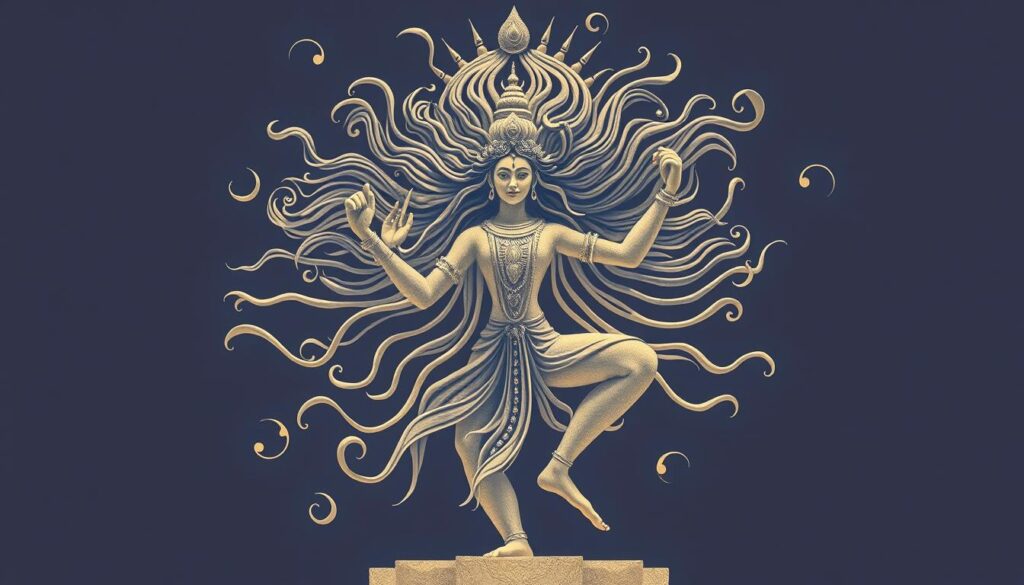
In Hindu deities, Nataraja stands out. It’s Lord Shiva as the cosmic dancer. This image shows the universe’s dance of creation, keeping, and ending.
The Significance of the Dancing Form
The Nataraja sculpture is more than a statue. It shows the universe’s energy and connection. Shiva, as the Lord of Dance, dances beautifully. His dance shows the universe’s eternal rhythm.
The Circle of Cosmic Energy
A circle, or Prabha Mandala, surrounds the Nataraja. It’s like a cosmic egg. It shows life, death, and rebirth’s cycle. Shiva’s dance includes joy and destruction.
Elements of the Nataraja Form
The Nataraja sculpture is full of symbols. Shiva holds a Damaru for creation’s sound. He also has a flame, a gesture of fearlessness, and a hand for freedom.
The Nataraja comes from Southern India. It shows creation’s joy and the dance from stillness. This image is known worldwide. It inspires art, science, and spirituality.
The Five Acts of Shiva’s Cosmic Dance

Shiva’s cosmic dance is a deep story with five parts. It shows the universe’s endless cycle. The five acts, or Panchakriyas, are creation (srishti), preservation (sthiti), destruction (samhara), concealment (tirobhava), and revelation (anugraha). This dance is key to Shiva’s role as the universe’s creator, keeper, and destroyer.
- Creation (Srishti): Shiva’s dance starts creation, bringing new life and things into being.
- Preservation (Sthiti): The dance keeps things going, keeping the universe in balance.
- Destruction (Samhara): Shiva’s dance also destroys old things to make room for new ones.
- Concealment (Tirobhava): The dance hides the truth, keeping the divine mystery secret.
- Revelation (Anugraha): The dance ends with revealing deep spiritual knowledge, freeing the soul.
Shiva’s tandava nritya, or cosmic dance, shows the universe’s constant change. Through this dance, Shiva shows how creation, preservation, and destruction work together.
| Act of Shiva’s Dance | Significance |
|---|---|
| Creation (Srishti) | Starts creation, bringing new life and things into being. |
| Preservation (Sthiti) | Keeps things going, keeping the universe in balance. |
| Destruction (Samhara) | Destroys old things to make room for new ones. |
| Concealment (Tirobhava) | Hides the truth, keeping the divine mystery secret. |
| Revelation (Anugraha) | Ends with revealing deep spiritual knowledge, freeing the soul. |
“The dance of Shiva is the image of his rhythm of creation, preservation and destruction.” – Fritjof Capra, The Tao of Physics
Symbolism in Shiv Tandav
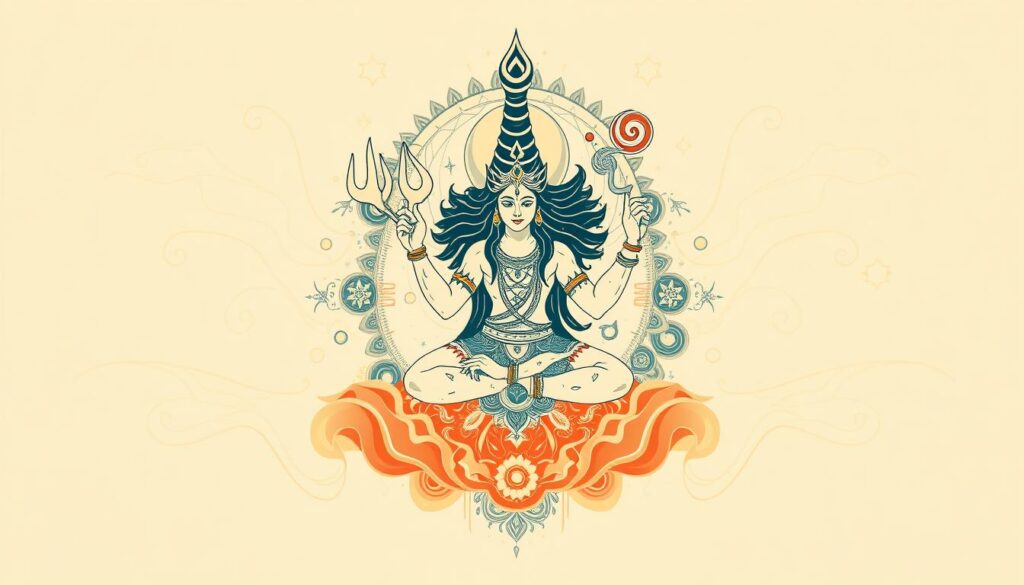
The Shiv Tandav is a dance of Lord Shiva that shows the cycle of life. It has symbols that tell us about the universe.
The Damru and Sacred Sound
The Damru is a drum at the heart of Shiva’s dance. It makes the sound of creation. This sound is the start of the universe.
The Damru is the sacred sound that everything comes from.
The Fire of Transformation
Shiva holds the fire of transformation. This fire destroys old things to bring in the new. It shows the cycle of change in the universe.
The Cosmic Balance
The dance of Shiva shows the balance of the universe. It mixes creation and destruction, life and death. This balance is what makes the universe work.
The Shiv Tandav teaches us about the universe and our place in it. It shows the secrets of life and existence.
The Scientific Perspective of Shiv Tandav
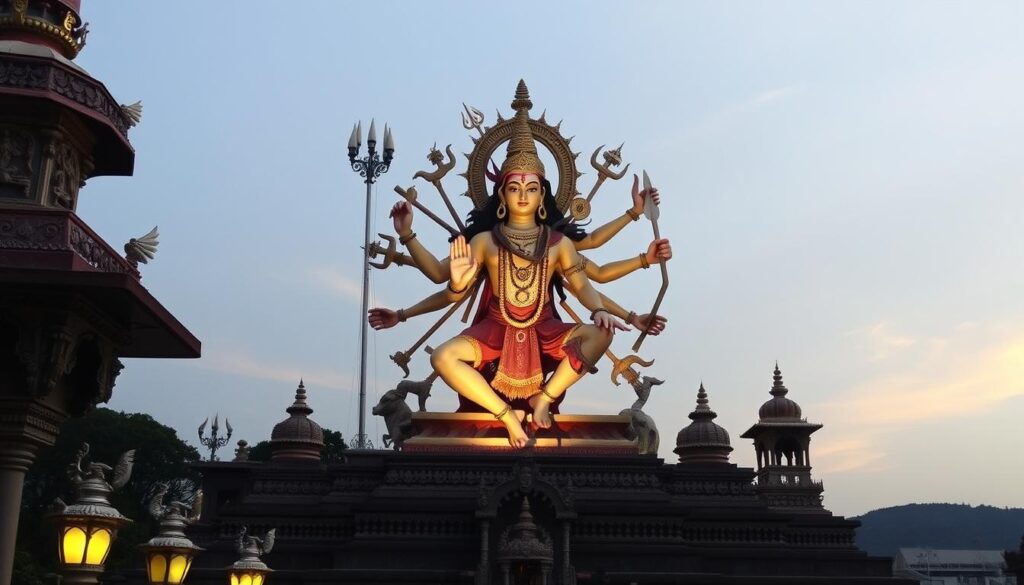
The dance of Lord Shiva, called Shiv Tandav, is very important. It’s not just in myths but also in physics today. A big statue of Lord Shiva dancing was unveiled at CERN on June 18, 2004. This event showed how science and ancient traditions can meet.
The statue at CERN shows Lord Shiva’s cosmic dance. This dance is thought to start the cycle of creation, keeping things going, and ending things. Physicists at CERN see Shiva’s dance as a dance of tiny particles. This shows a link between old myths and new physics.
“The Shiva cosmic dance is the source of all movement in the universe. Shiva’s dance is the dancing universe, the ceaseless flow of energy going through an infinite variety of patterns that melt into one another.”
– Fritjof Capra, physicist
The Shiva Project at CERN wants to see how dance affects tiny particles. This shows scientists are curious about the links between old wisdom and new cosmic cycles.
The constructal theory says design is the same everywhere, from tiny atoms to the whole universe. This idea matches the yogic view of life, the self, and the universe as connected. This shows how physics and mythology can share deep insights about the microcosm and macrocosm.
The Nataraja statue at CERN is a symbol of the talk between old wisdom and new science. It shows the timeless nature of the cosmic cycles. It also shows how ancient Indian traditions can help us understand the universe.
The Spiritual Significance of the Cosmic Dance
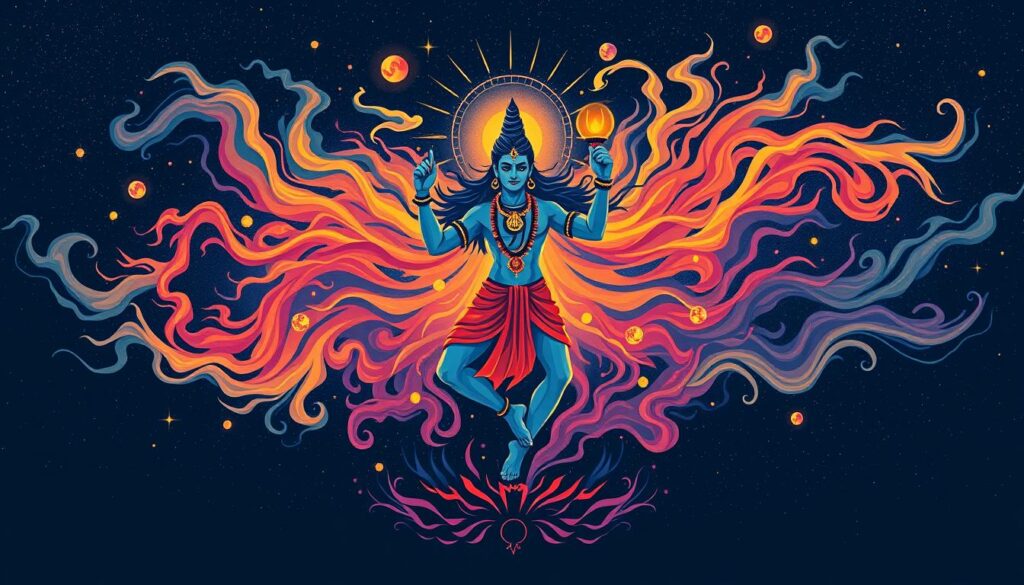
The Shiv Tandav, or the cosmic dance of Lord Shiva, is a deep spiritual journey. It shows the cycle of creation, keeping things alive, and then ending. It teaches us to find peace in life’s chaos.
Transcendental Movement
The Shiv Tandav helps us move beyond the physical world. It connects us to the universal consciousness through dance and meditation. The dance’s poses help clear energy blocks and understand the universe’s secrets.
Connection to Universal Consciousness
The Shiv Tandav is more than just dance steps. It’s a path to spiritual enlightenment. The dance and music guide us to a higher state. There, we can connect with the divine and feel the transcendental dance of the cosmos.
“The Shiv Tandav is a dance of life and death, a celebration of the eternal cycle that governs our existence. It is a reminder that even in the midst of chaos, there is a profound harmony that can be found through the rhythmic embrace of the divine.”
By joining the Shiv Tandav, we learn about the connection of all things. It helps us feel the universal consciousness that goes beyond our world.
Forms of Tandava: From Destruction to Bliss
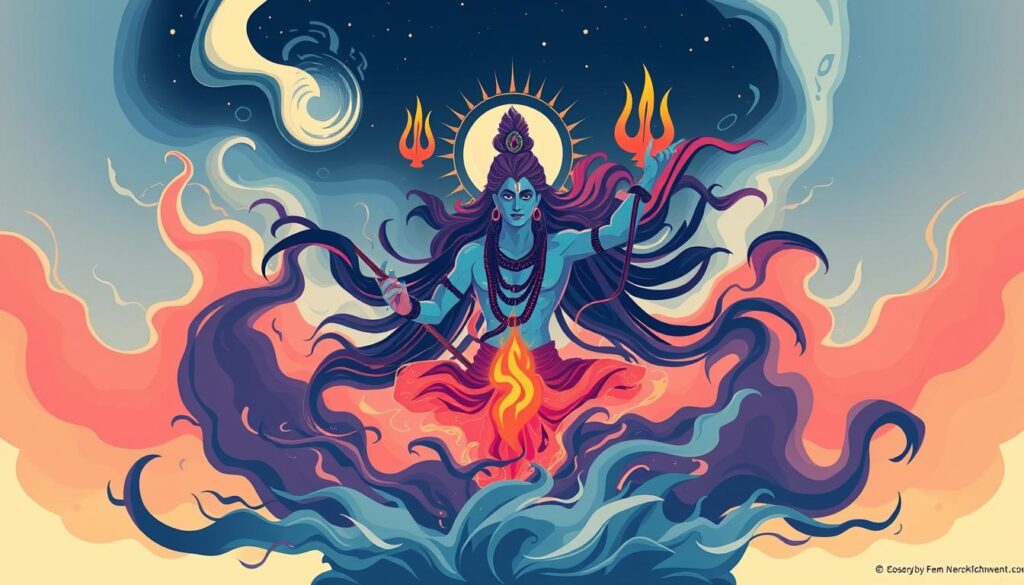
Lord Shiva’s cosmic dance, called Shiv Tandav, shows different sides of life. It ranges from the fierce rudra tandava to the joyful ananda tandava. These dances show the full range of cosmic energies and life cycles.
The rudra tandava shows Shiva’s angry side. His powerful moves destroy evil and end the world. On the other hand, the ananda tandava shows Shiva’s happy side. It shows how he brings life and joy.
The samhara tandava is about ending things. Shiva’s steps show the cycle of making and breaking. This dance shows the balance and order in the universe.
The lasya tandava is gentle and beautiful. Shiva’s moves are elegant and caring. This dance shows how Shiva keeps the world in balance.
These different dances of Shiv Tandav teach us about life. They show how things are made, kept, and ended. The Hindu tradition celebrates the changing yet harmonious universe through these dances.
Musical Elements and Rhythmic Patterns
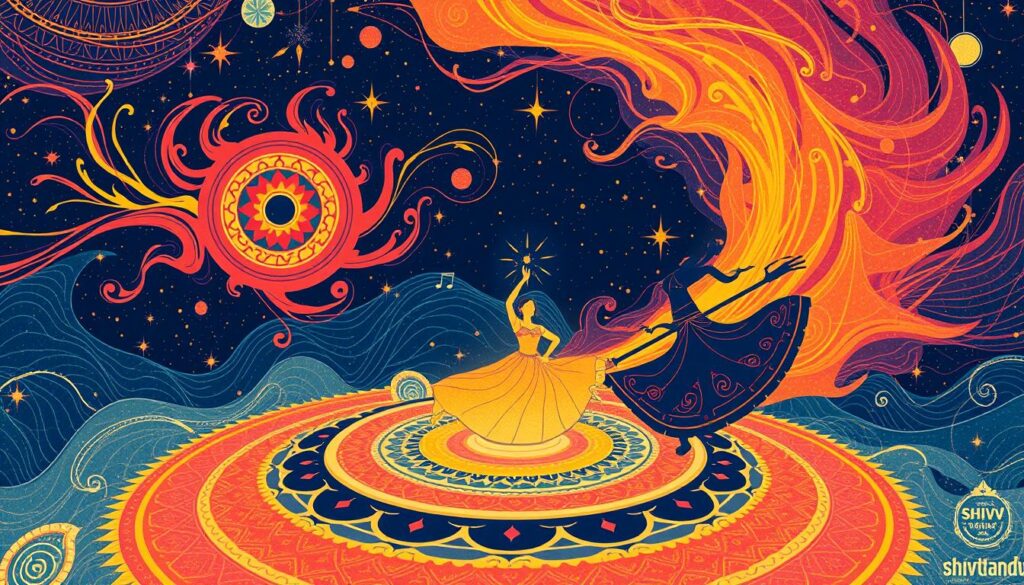
The music for the Shiv Tandav, Lord Shiva’s cosmic dance, is very important. It uses traditional Indian instruments like the damaru, tabla, flute, and sitar. These instruments make a beautiful sound that goes with the dance.
The damaru’s steady beats remind us of the universe’s creation. Other instruments add special rhythms and melodies. Together, they make a mix of cosmic rhythms that amazes us. The dance and music together bring a deep feeling of connection to the divine.
| Instrument | Significance |
|---|---|
| Damaru | The beats of the damaru symbolize the creation of the universe, representing the heartbeat of the cosmos. |
| Tabla | The tabla, a pair of hand drums, provides intricate rhythmic patterns that accentuate the dynamism of the tandava music. |
| Flute | The haunting melodies of the flute evoke a sense of spiritual transcendence, complementing the meditative nature of the tandav mantras. |
| Sitar | The sitar’s rich, resonant tones weave a tapestry of sound, creating a captivating musical landscape for the divine dance. |
The music of the Shiv Tandav is based on Indian classical music. It uses special rhythms and melodies. This makes the dance even more spiritual and moving.
“The music of the Shiv Tandav is a transcendent symphony, where the beats of the cosmos and the movements of the divine converge to create a transformative experience for the soul.”
The Shiv Tandav combines music, movement, and spiritual meaning. It takes us on a journey of self-discovery. We connect with the universal rhythms that shape our world.
The Impact on Indian Classical Dance
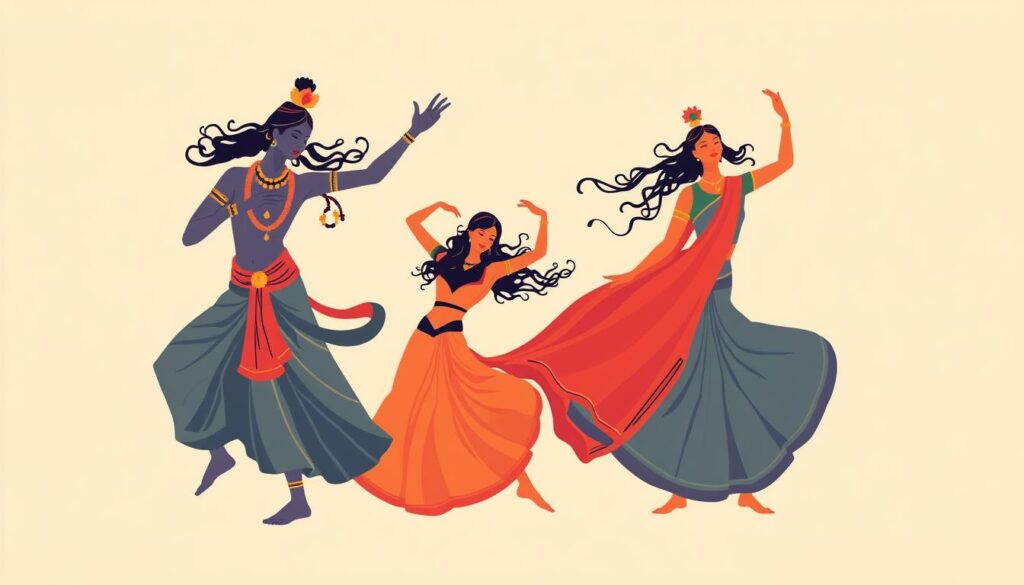
Shiv Tandav, the cosmic dance of Lord Shiva, has deeply influenced Indian classical dance. It has been mixed into Bharatanatyam, Kathak, and Odissi, and more.
Traditional Dance Forms
Bharatanatyam, Kathak, and Odissi draw from Shiv Tandav. They use poses and movements inspired by Lord Shiva. These dances show the cosmic dance of creation, preservation, and destruction.
Modern Interpretations
Today, dance still finds inspiration in Shiv Tandav. It mixes old traditions with new styles. This creates performances that connect the past and present.
Shiv Tandav’s impact on dance shows its lasting power. It inspires dancers to explore human feelings and the universe’s secrets.
| Dance Form | Influence of Shiv Tandav |
|---|---|
| Bharatanatyam | Poses and movements inspired by the Nataraja form, emphasizing the balance between the masculine and feminine aspects of the divine dance. |
| Kathak | Intricate footwork and rhythmic patterns that mimic the cosmic dance, often accompanied by the rhythmic sounds of the damru, a sacred instrument associated with Lord Shiva. |
| Odissi | Graceful, fluid movements that evoke the cosmic energy of Shiv Tandav, with a focus on the spiritual and meditative aspects of the divine dance. |
“The dance of Shiva is the dance of the universe. It is the eternal rhythm of creation, preservation, and destruction.”
Sacred Temples and Shiv Tandav
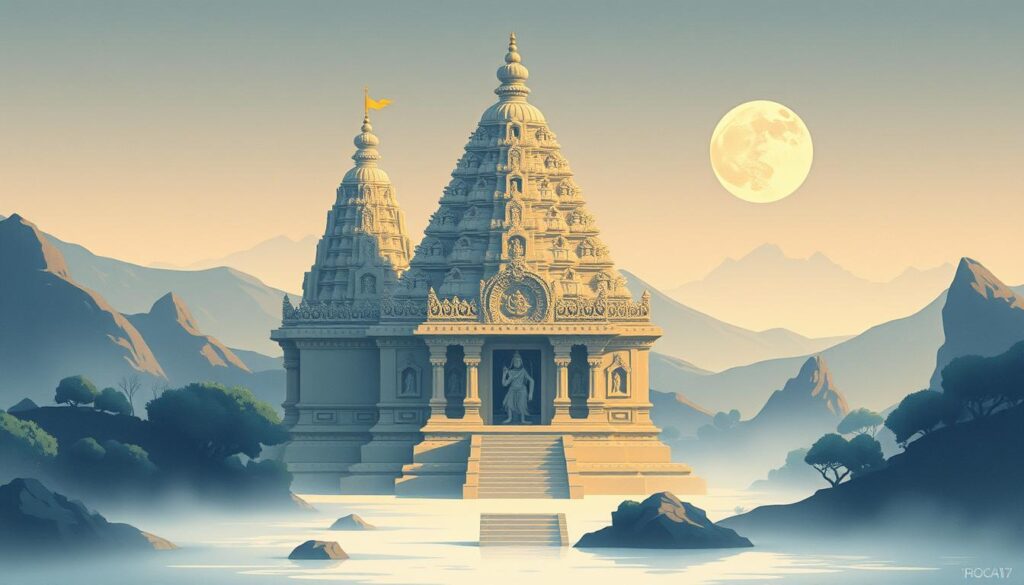
The sacred temples dedicated to Lord Shiva’s cosmic dance, Shiv Tandav, are very important. The Chidambaram temple in Tamil Nadu is especially significant. It has the famous Nataraja idol, showing Lord Shiva dancing.
Indian temples have detailed carvings and sculptures of Lord Shiva dancing. These places are for rituals, performances, and thinking deeply about Shiv Tandav. They keep the dance’s rich meaning alive and let it continue.
| Temple | Significance | Key Features |
|---|---|---|
| Chidambaram Temple | Considered the spiritual home of the Nataraja form of Lord Shiva | Houses the famous bronze idol of Nataraja, depicting Shiva’s cosmic dance |
| Ekambareshwar Temple | Known for its association with the Shiva Tandava Stotram, a hymn composed by Ravana | Hosts annual festivals and performances celebrating the Shiv Tandav |
| Elephanta Caves | Showcases intricately carved rock-cut sculptures of Shiva in his Tandava form | Highlights the artistic and spiritual significance of the Shiv Tandav |
These temples are important for culture and spirituality. They keep the Shiv Tandav alive and celebrated. They inspire artists, scholars, and followers, showing the beauty of creation and change.
“The Shiv Tandav, in its various forms, is a testament to the dynamic nature of the cosmos, where creation, preservation, and destruction are all part of the eternal cycle.”
Meditative Aspects of the Divine Dance
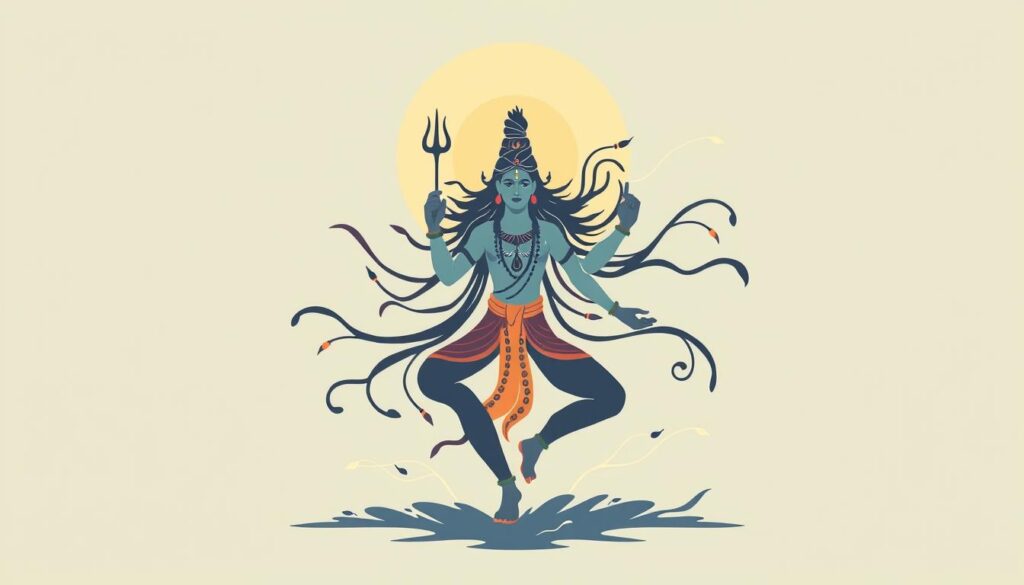
The Shiv Tandav, or the cosmic dance of Lord Shiva, is a deep meditation. It harmonizes body, mind, and soul. It can unlock transcendental movements and enlightening experiences.
The dance aims to connect with the universal consciousness. Practitioners move slowly, in sync with the music. They aim to feel one with the divine.
- The Shiv Tandav Stotram, a hymn by Ravana, has 16 verses. They celebrate Shiva’s cosmic dance.
- The verse “Jata Kataha Sambhrama…” talks about Shiva’s locks flowing with the Ganga. It shows the dance’s link to life and balance.
- Shiva as Nataraja, the Lord of the Dance, shows his victory over ignorance. He guides us to spiritual awakening.
Doing the Shiv Tandav is a journey of self-discovery. It uses dance to reach deeper meditation. It helps us understand our connection to everything.
“The Shiv Tandav is not just a dance, but a sacred ritual that invites the practitioner to transcend the boundaries of the self and merge with the universal rhythm of creation.”
Conclusion
The cosmic dance of Lord Shiva is called Shiv Tandav. It shows the cycle of creation, destruction, and change. This dance is a symbol of how everything in the universe is connected.
It teaches us about the balance between chaos and order. It helps us find ourselves and grow spiritually.
This dance has inspired many through art, culture, and spirituality. It connects old wisdom with today’s understanding of the universe. The Shiva Tandava Stotram’s images and themes of balance and harmony touch hearts worldwide.
The Shiv Tandav reminds us of our link to the universe’s rhythm. It encourages us to live life’s ever-changing dance and seek spiritual growth. Reflecting on this dance, we see the beauty and wisdom in life’s cycles.
FAQ
What is Shiv Tandav?
Shiv Tandav shows the cycle of life in Hindu stories. It’s Lord Shiva’s dance that shows the universe’s constant change.
What does the Nataraja form of Shiva represent?
The Nataraja form shows the universe. The circle around Nataraja is the cosmic dance. It means Shiva, or empty space, makes everything happen.
What are the five acts of Shiva’s cosmic dance?
Shiva’s dance has five acts. They are creation, preservation, destruction, hiding, and revealing. These acts show the universe’s endless cycle.
What are the key symbolic elements in Shiv Tandav?
Shiv Tandav has important symbols. The Damru means creation’s sound. Fire in Shiva’s hand is destruction. Ganga from his hair is life’s flow. The crescent moon shows time’s cycle.
How does modern physics relate to the concept of Shiv Tandav?
Modern physics connects with Shiv Tandav. Constructal theory says design is the same everywhere, like in yoga. A Nataraja statue at CERN links ancient wisdom with science.
What are the different forms of Tandava dance?
Tandava dance has many forms. Rudra Tandava is fierce and destructive. Ananda Tandava is joyful creation. Samhara Tandava is dissolution. Lasya Tandava is divine grace.
How has Shiv Tandav influenced Indian classical dance forms?
Shiv Tandav has shaped Indian dances like Bharatanatyam and Kathak. Their moves are inspired by Nataraja. Modern dances also use Shiv Tandav, mixing old and new.
What is the significance of sacred temples dedicated to Shiv Tandav?
Temples like Chidambaram in Tamil Nadu are key. They keep Shiv Tandav alive. The temple’s art shows Shiva’s dance, a place for rituals and thought.
How can Shiv Tandav be used as a meditative practice?
Shiv Tandav is great for meditation. Its rhythm and focus help reach deep calm. It aims to unite body, mind, and soul, seeking spiritual growth.


